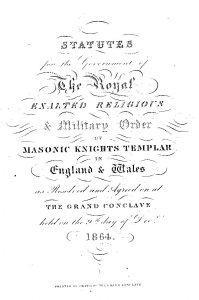Masonic Knights Templar
There are many organizations around the world that take their inspiration and their name from the historical Knights Templar. Most are charitable groups who are inspired by the Knights dedication to chivalry and their refusal to surrender during battle. The most important of which is the Masonic branch of Knights Templar.
While the connection to the historic Knights Templar is tentative at best, Freemasons offer membership to Christian Masons on the York Rite path who have been successfully initiated into the Royal Arch. Great debates still continue concerning whether or not there was ever an “official” meeting point of Templarism and Freemasonry. Many of today’s Freemasons attribute the introduction of Templar traditions to Andrew Ramsay in the year 1713, while others maintain he did no more than deliver a speech concerning the Templars in that same year which gave way to much of the colourful legend surrounding the Order. In December 1778 the Lodge of Scoon and Perth conferred the “six sundry steps of Masonry” on the Office-bearers of St. Stephen´s Lodge in Edinburgh, ie. “Past the Chair, Excellent and Super Excellent Mason, Arch and Royal Arch Mason and, lastly, Knights of Malta”. In his History of Freemasonry, Robert Gould notes: The draft of a certificate preserved at York for the five Degrees of January 26, 1779, to November 29, 1779, is the earliest official document known in Great Britain and Ireland relating to Knights Templar in connection with Freemasonry. However it is also noted that in 1730 two Lodges appeared in London claiming to practice a new form of Masonry, the Rite de Bouillon, which embraced the three usual degrees plus Scottish Master, Novice and Knight of the Temple. The flourishing state of Symbolic Masonry under the protection of H. R. H. the Prince of Wales (afterwards George IV.), Grand Master, and the great increase of Royal Arch Chapters patronized by H. R. H. the Duke of Clarence (afterwards William IV.), encouraged the Masonic Knights Templar and the Knights Hospitallers of St. John of Jerusalem, Palestine, Rhodes, and Malta, now called the Knights of Malta, to revive their ancient Royal Religious and Military Orders. This resulted in the installation of Brother and Knight Companion, Thomas Dunkerley, of Hampton Court Palace, as Grand Master of the Confraternity under the Patronage of H. R. H. Prince Edward (afterwards Duke of Kent). On the 24th of June, 1791, a Grand and Royal Conclave was held at which the ancient Statutes of the Orders were revised, reenacted, and unanimously approved.

The final revision and a printed version was issued in 1864 by Grand Director of the Ceremonies W.J. Meymott.
John Hamill, communications director of the United Grand Lodge of England states: “We don’t claim any descent. (This Masonic Degree) originated as a means of commemorating the original Templars and of exemplifying certain Masonic principles.” The most practically important is charity work. The St John Eye Hospital in Jerusalem is a charitable foundation of the (non-Masonic) Venerable Order of St John, the oldest charity in the world. This hospital is recipient of much of the fundraising. As previously stated, membership of the Knights Templar is by invitation only. Candidates are required to be Master Masons and Royal Arch Masons. They should also sign a declaration that they profess the Doctrine of the Holy and Undivided Trinity. Local bodies of Knights Templar are known as Preceptories, local bodies of Knights of St Paul are known as Chapters and local bodies of Knights of Malta are known as Priories. All operate under a Grand or Great Priory, often with an intermediate level of Provincial Priories. Although some jurisdictions maintain a separate Great Priory of the Temple and Great Priory of Malta (as, for example, in England), the Grand Master and other officers of both Great Priories hold simultaneous equal office in both bodies. Three degrees are administered in this system: The Degree of Knight Templar (Order of the Temple) The Degree of Knight of St. Paul (incorporating the Mediterranean Pass) The Degree of Knight of Malta (Order of Malta).
